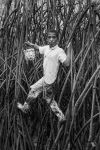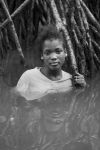For ten years, Ecuadorian-born Felipe Jácome has documented young Afro-Ecuadorian citizens who work as shell pickers in order to provide for their families in his ongoing project Lord of the Mangrove. Jácome photographed the series in the Cayapas Mataje Mangrove Reserve in Northern Ecuador, an area that boasts the tallest Mangrove trees in the world. These mangroves are remarkably large, with intertwined roots and striking forms.
The complexity of the trees’ structures, however, is no challenge for the experienced shell pickers, who learned to scale the trees in order to hunt for their prize: tiny black shells that are buried amidst the roots. The pickers endure neck-deep waters in order to earn a mere eight cents per shell. In the city, the demand for the black shells is based on their status as a culinary delicacy. A few shells in a savory dish could cost around ten dollars—a market price that is considerably higher than the shell pickers’ earnings.

“When I showed up in the Reserve, they [the community of shell pickers] said, ‘It is important that you document—that you take pictures of this. People need to understand how hard it is,’” Jácome explains. This was the point at which he understood the importance of his role as a photographer. His previous experience with human rights projects granted Jácome an awareness that you cannot just enter a place, take a picture, and then simply leave. It was important to him that he maintain a close friendship with the citizens in order to pursue a collaborative dialogue with his subjects.
Since the shell pickers, who are known as “concheros,” start working at a young age, Jácome had the opportunity to watch families and children over time. For many years, he has stayed with them, slept between them and even partied with the community. “You need to be there, you need to have empathy,” he says. “You need to be part of what is going on in order to take the picture.”

In Jácome’s photographs, the children’s expressions are often solemn, and many of them look directly towards the camera. In the seam of these gazes, though, we see fleeting smiles and glimpses of amusement; the kids hang upside down off a tree, or humorously pose with shells. For Jácome, the portrayal of these chirpier scenes amidst the laborious work was an important objective of the project; it was crucial that the viewer remember that these are children. This aspect of the work also needed to be balanced with the solemnity and sensitivity necessary in a project depicting child labor.
Jácome’s relationship to the community was (and is) pivotal. His black-and-white portraits are considerate and respectful, and Jácome remains conscious of his role and gaze. Along with his goal to shed light on this practice, Jácome also feels a strong sense of responsibility and an urge to give back to this community. He explains, “I believe photography needs to be useful, whether it’s to push for a cause or to document.”

Last year, the opportunity emerged for an exhibition of the work to take place in Ecuador. Opposing suggested ideas to exhibit the work within the local community, Jácome instead decided to exhibit it in the forest of the Cayapas Mataje Reserve, right where the images were taken. For Jácome, the location was crucial: the work is not just about the people—it is also about the forest. This was the first ever exhibition to take place in the Mangroves, and it was also the first time the communities in the area had ever encountered an art exhibition.
For the exhibition, the photographer made exceptionally large prints (each around five or six metres wide) and hung them high up in the trees. Jácome received a small grant from an NGO for working in the mangrove, and he used it to hire boats that could transport the communities to and from the exhibition. He describes how the children excitedly arrived at the Mangrove exhibition, pointing out the familiar faces in the images. “They understood this was my way of saying thank you,” he says.

Jácome was determined to give something back to the community beyond his site-specific exhibition and the 6x4 prints he made for them as keepsakes. As he worked on the project, he became aware of a major obstacle in the community: the only way for children to attend school after the ninth grade was to move to the city, away from their homes, parents and friends. So, the photographer has managed to fundraise enough money to build a boat, granting children the opportunity to continue their studies. Since Lord of the Mangrove is an ongoing project, he hopes to return to the area to document these boat journeys as a next phase in the series.
—Lauren Jackson
Felipe Jácome’s series “Lord of the Mangrove” was Jim Casper’s juror’s pick in our Portrait Awards 2018. Explore work by all 39 of the winners, finalists, and jurors’ picks.










